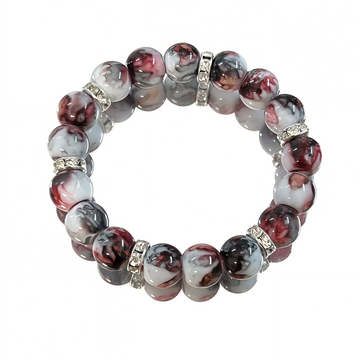Environment-Specific Maintenance Tips for Stone Bracelets
Stone bracelets, crafted from materials like jade, quartz, or agate, require tailored care to withstand varying environmental conditions. Temperature fluctuations, humidity levels, and exposure to chemicals can all impact their durability and appearance. Below are actionable strategies to protect your bracelet in different settings, ensuring its longevity and aesthetic appeal.
Maintaining Stone Bracelets in Humid Environments
High humidity can lead to moisture absorption in porous stones, causing discoloration, warping, or adhesive failure. Follow these steps to safeguard your bracelet:
- Limit Wear Time: Avoid prolonged exposure to humid conditions, such as rainy seasons or tropical climates. Remove the bracelet before activities like swimming, showering, or gardening to prevent water infiltration.
- Proper Storage: Store the bracelet in a dehumidified environment, such as a sealed jewelry box with silica gel packets. For long-term storage, wrap it in a soft, acid-free cloth to absorb residual moisture.
- Regular Inspections: Check for signs of mold, mildew, or surface dullness. If moisture damage occurs, gently clean the bracelet with a dry microfiber cloth and allow it to air-dry in a shaded, ventilated area.
Protecting Bracelets in Dry or Arid Climates
Low humidity can cause certain stones, like opal or turquoise, to dry out and crack. Mitigate these risks with these preventive measures:
- Hydration Treatments: For porous stones, apply a thin layer of natural oil (e.g., jojoba or mineral oil) every 3–6 months. This helps retain moisture and prevents brittleness.
- Avoid Extreme Temperature Shifts: Sudden transitions from dry heat to cold air (e.g., entering air-conditioned spaces) can stress the stone. Remove the bracelet during such shifts or store it in an insulated pouch.
- Monitor for Cracks: Inspect the bracelet regularly for fine lines or fissures, especially along edges or stress points. If cracks appear, consult a professional for stabilization to prevent further damage.
Caring for Stone Bracelets in Chemical-Rich Environments
Exposure to household cleaners, cosmetics, or industrial chemicals can erode the stone’s surface or weaken adhesives. Adopt these habits to minimize risk:
- Remove Before Chemical Use: Take off the bracelet before applying lotions, perfumes, hairsprays, or cleaning products. Allow skincare items to fully absorb before wearing the bracelet again.
- Neutral Cleaning Solutions: If the bracelet comes into contact with chemicals, clean it immediately with lukewarm water and a mild, pH-neutral soap. Avoid harsh detergents or abrasive scrubbers.
- Protective Coatings: For stones prone to staining (e.g., marble or calcite), consider applying a temporary sealant. Reapply as needed to maintain a barrier against acidic substances.
Handling Bracelets in High-Activity or Outdoor Settings
Physical impacts, UV exposure, and temperature extremes pose risks during outdoor activities. Follow these guidelines to preserve your bracelet:
- Secure Storage During Activities: Remove the bracelet before sports, hiking, or manual labor to prevent scratches, chips, or fractures. Store it in a padded pouch or compartment to avoid collisions.
- UV Protection: Prolonged sunlight exposure can fade certain stones, like amethyst or citrine. Limit wear during peak sun hours or opt for bracelets with UV-resistant stones.
- Temperature Adaptation: In cold climates, avoid exposing the bracelet to freezing temperatures, as thermal shock can cause fractures. In hot environments, prevent direct contact with heated surfaces (e.g., car dashboards).
By adapting your maintenance routine to the environment, you can ensure your stone bracelet remains vibrant and intact. Whether in humid, dry, chemical-laden, or outdoor settings, proactive care protects your investment and preserves its natural beauty.







